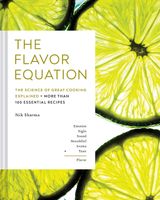Advertisement
How Bitterness Works
Appears in
By Nik Sharma
Published 2020
We are very sensitive to detecting bitter-tasting molecules at extremely low levels. Compared to our ability to taste sugar (detected at 25 µmol/l, or micromole per liter), we can taste bitter compounds at a very low concentration—such as quinine, the active ingredient in tonic water (detected at 10,000 µmol/l); that’s a factor of 400! And the perception of bitterness sticks around longer compared to other tastes. Our genetics also make some of us much more sensitive to the taste of bitterness in food (it’s unconfirmed, but I think I’m one of them); these people are called supertasters. Due to a variation in the gene that codes for the bitter taste receptor, these folks are bitter averse and will typically prefer the taste of sweet foods.

